
Visit Shrines
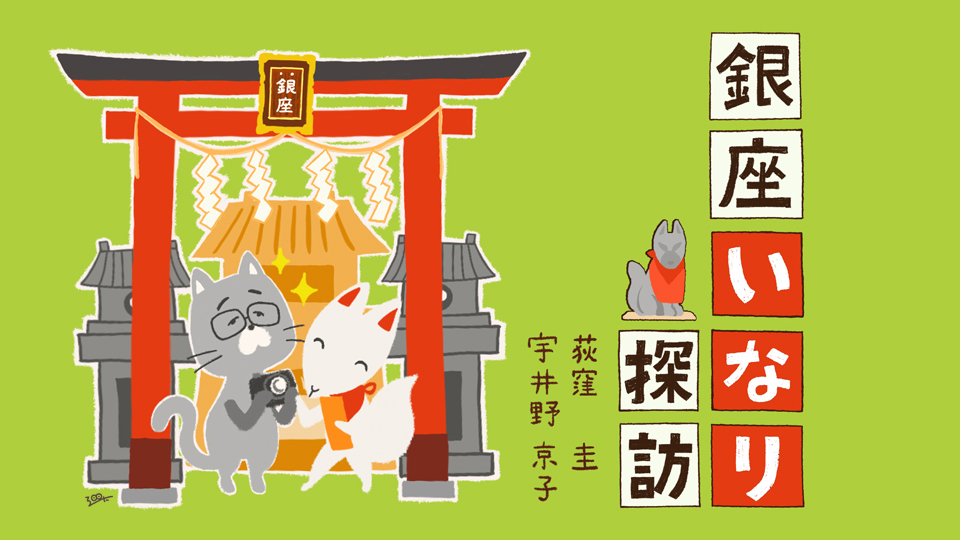
Visit Ginza’s Inari Shrines Vol.14 Hoju Inari Shrine
2023.05.01
Adjacent to Nihonbashi and Tsukiji, important areas in the food network, Ginza flourished as a merchants’ town from the Edo period. The vibrance of the market and gallantry of the tradesmen seems to have beenthe source of Ginza’s energy.

- Uino
- Ogikubo-san, do you know what a “Jiguchi-andon” is?
- Ogikubo
- Ah, yes. In Senjujuku, there is an old family who made “ema” (votive wooden tablets with a picture of a horse) and “Jiguchi-andon” under the name Yoshidaya since the Edo period. Their jiguchi-andon are used to illuminate the streets during the local autumn festival in September. I had the opportunity of seeing real jiguchi-andon when I happened to visit Senju in September. I recall they were square lanterns with something written on it. Actually, I was guiding visitors then and I only briefly explained to them that they were jiguchi-andon. Therefore, I didn’t have the chance to read through anything or take pictures.
- Uino
- Then, let me show you some pictures. These are jiguchi-andon from Hoju Inari-san in Ginza.
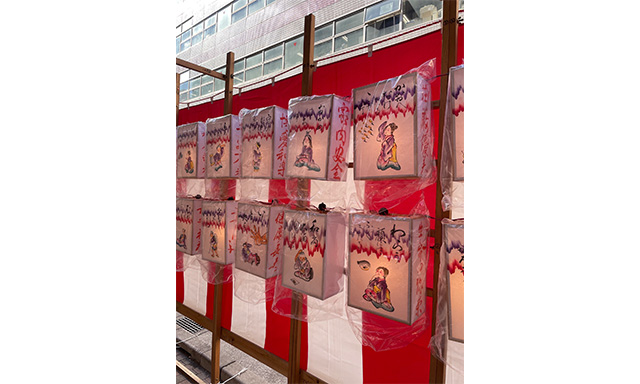
- Ogikubo
- Oh. The ones I saw were like this too. The naïve puns written on them bear the Edo essence. “A smile on the face brings good globefish (fugu).” (Note: The original proverb is “A smile on the face brings good fortune (fuku).”) And there is a globefish really approaching in the drawing.
- Uino
- There is another one with a fox.
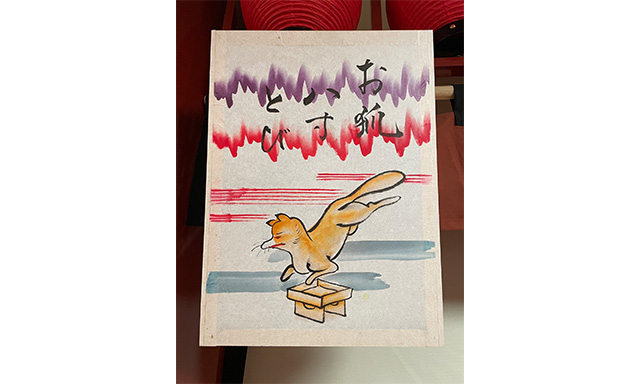
- Ogikubo
- The original verse is “Yoshitsune hasso-tobi,” right? Yoshitsune has been reread as “okitsune (fox)”!
- Uino
- This witty play on words is so representative of Japanese culture. Our destination today is the shrine in this picture, Hoju Inari Shrine.
- Ogikubo
- Hoju Inari – that is a new name to me.
- Uino
- Then let us go there. Its address is in Ginza 3-chome, but the closest station is Higashi-Ginza. It is behind the Kabukiza Theater.
- Ogikubo
- It is in front of Magazine House. I have visited Magazine House several times for work, but I never realized that there was a shrine there.
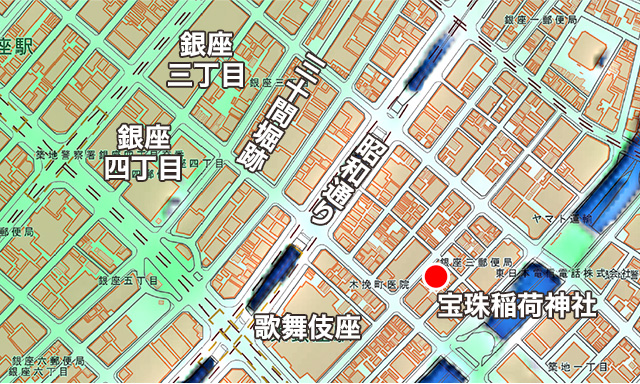
around the back side of the Kabukicho Theater.
- Uino
- It is relatively recently that Hoju Inari Shrine joined Ginza’s autumn event, “Haccho Jinja Meguri.” The Haccho Jinja Meguri was launched as an event among the Inari Shrines in Ginza that are parishioners of Hie Shrine, so perhaps Hoju Inari Shrine, under the jurisdiction of Teppozu Inari Shrine, was considered to belong to a different area. As you know, it is beyond Showa Dori. By the way, there used to be a river running where Showa Dori is now, right?
- Ogikubo
- Actually, Showa Dori wasn’t built over a river. If you refer to an old map, this area used to be Kobikicho, not Ginza. I brought a map of Kyobashi-ku from 1941 (Showa 16) with me today. Sanjikken-bori acts as the borderline between Ginza 3-chome and Kobikicho 3-chome. Hoju Inari Shrine can also be found where it sits now.
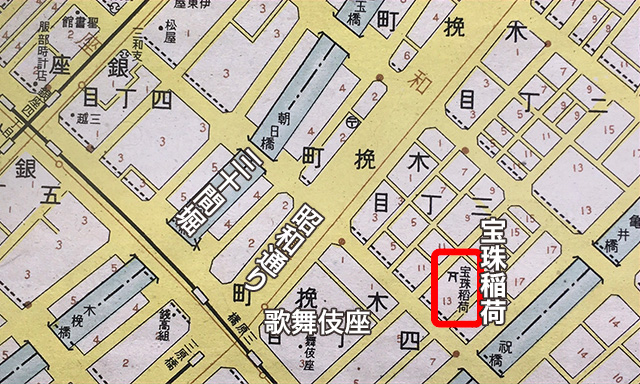
from “Kyobashi-ku Shosai-zu” (Nihon Tosei Chizu)
Both Sanjikken-bori and Showa Dori are included,
as well as Hoju Inari Shrine, in the same place as today.
- Uino
- Really! Oh that is right. Sanjikken-bori, where Sangenbashi Bridge used to be, ran one block away from Showa Dori on the Ginza side. It is clear on this map. I am so happy to see Hoju Inari Shrine on the map. It shows that the shrine was an important part of the local community.
- Ogikubo
- Showa Dori was built as a road to support the restoration after the Great Kanto Earthquake. With an underpass, it is deep and wide, so it looks as though it was built over a river. The area from Sanjikken-bori outwards used to be called Kobiki-cho. It was named Kobiki-cho because in the early Edo period when the Edo Palace was under construction, “kobiki” craftsman, or sawyers, lived in the area. Kobiki craftsman processed the lumber and cut it into wood pieces, right? This area faced the sea so the lumber must have been processed here and taken to Edo Palace. I wonder if Hoju Inari Shrine was the guardian god for these activities.
- Uino
- The history of the shrine says that its origin goes back to around 1615 when the Itakura family had the divided tutelary deity transferred to their mansion as a fire prevention god. But for craftsman working with wood, fire prevention must have been an important blessing/
- Ogikubo
- Let us look at an old map of Edo to find the Itakura family.
A map of Edo from 1666 has the name “Itakura” on it. And it is right around 3-chome. Is the current location of Hoju Inari Shrine just at the edge of the premises of the Itakura family’s mansion?
![寛文六年(1666)の江戸絵図を見ると、木挽町三丁目のあたりに板倉の名が。ここにあったのだろうか(『[江戸図寛文六年刊]』国立国会図書館デジタルコレクションより)](/wp-content/uploads/visit-shrines14_05.jpg)
the name “Itakura” can be found around Kobiki-cho 3-chome. This could have been the original location of the shrine.
(“Edo-u Kanbun 6-nen-kan” (from the National Diet Library Digital Collection)
- Uino
- I see. So, the shrine was originally located there.
- Ogikubo
- According to the shrine’s history, it was given to the Kamei family in 1760 and sold to the Okazaki family in the Taisho period. However, the shrine and land were later donated to the parishioners of Kobiki 3-chome. The adjacent land was acquired, and the shrine pavilion and office were constructed in 1950 (Showa 25). Although it is currently crowded in by buildings, if you take a close look, it has quite a grand pavilion. It bears the atmosphere of a shrine that has had a close relationship with the local community.
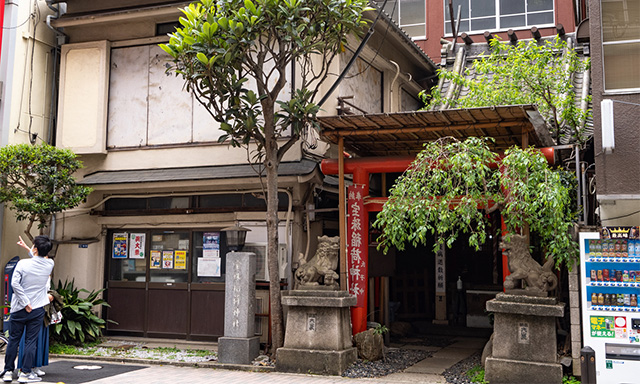
The shrine pavilion can be seen in the back.
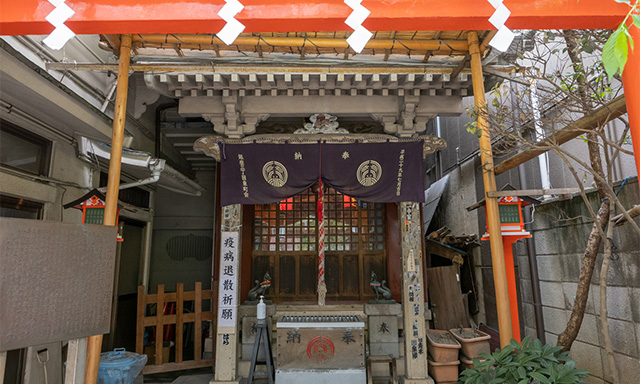
- Uino
- The premises have a special atmosphere. Beautiful, yet powerful guardian foxes greet us in.
- Ogikubo
- You are right. They are very handsome. One holds a jewel and the other, a key. Inari shrines which represent business property often have guardian foxes clutching the keys to the warehouse in their teeth. This adds to the impression that the shrine has been long cherished as a guardian of the neighborhood.
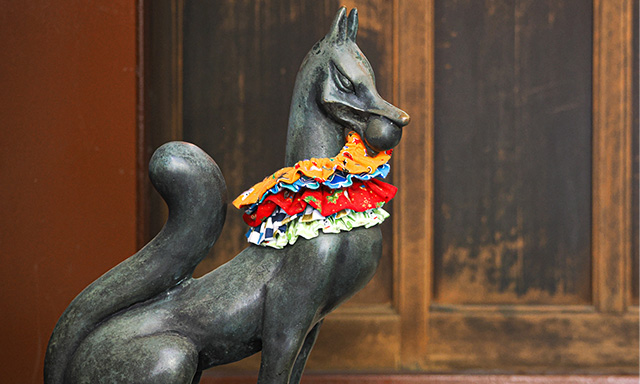
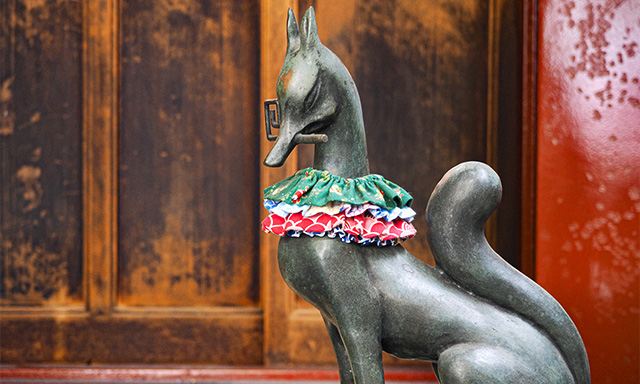
The foxes are slim and have a sharp look. One holds a jewel and the other, a key.
- Uino
- A festival that lets you feel the strong relationship between the shrine and its parishioners is held in May. Once every three years, there is a joint mikoshi (portable minature shrine) and horen (a mikoshi with a phoenix on the roof) parade with Teppozu Inari Shrine during its annual festival. The parishioners of each local community welcome the mikoshi and horen dressed in the same “hanten” short coats.
- Ogikubo
- Teppozu Inari Shrine is a very old shrine. It was founded during the Heian period and was worshiped as a guardian god of sea navigation in the Edo period because it was situated near the ocean. Located near the estuary of Sumida-gawa River, it is distant from Ginza.
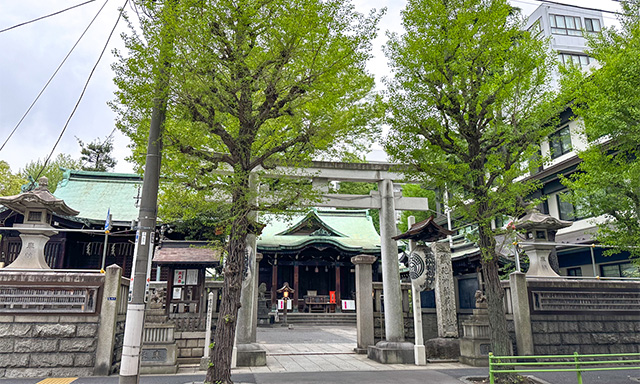
- Uino
- The route of the annual festival parade goes by Hoju Inari Shrine. Everyone looks very handsome in their short coats!
- Ogikubo
- So the parade route starts at Teppozu Inari Shrine, goes westward and around the area that used to be Kobiki-cho. That is something to look forward to. The fact that it does not cross Sanjikken-bori lets us re-acknowledge the old border.
Since the shrine is located beyond Showa Dori, it seems distant from Chuo Dori in Ginza. However, I hope that more people will visit the powerful Inari shrine/ - Uino
- Many people who have joined the Hacchobori Jinja Meguri event have commented that Hoju Inari Shrine was a beautiful shrine. It is beautiful and yet powerful, or maybe “proud” from an Edo perspective. I feel the energy of an athlete in Hoju Inari Shrine. Let us visit and receive its energy!
All List
- 2020.05.01 Visit Ginza’s Inari Shrines Vol.2 Asahi Inari Shrine
- 2020.08.01 Vol.3 Exploring Ginza in the Edo Period on an old map
- 2020.11.01 Visit Ginza’s Inari Shrines Vol. 4 Kakugo Inari Shrine
- 2021.02.01 Visit Ginza’s Inari Shrines Vol. 5 Azuma Inari
- 2021.05.01 Visit Ginza’s Inari Shrines Vol.6 Kabuki Inari
- 2021.08.01 Visit Ginza’s Inari Shrines Vol.7 Ginza Inari in Ginza 2-chome
- 2021.11.01 Visiting Ginza’s Shrines Vol. 8 Kumagai Inari Shrine
- 2022.02.01 Visit Ginza Shrines Vol. 9 Saiwai Inari Shrine
- 2022.05.01 Visit Ginza’s Shrine Vol. 10 Mimeguri Shrine and Shusse Jizoson on the roof of Mitsukoshi Department Store
- 2022.08.01 Visit Ginza’s Shrines Vol. 11 Komparu Inari
- 2022.11.01 Visit Ginza’s Inari Shrines Vol.12 Mankin Ryujin Seiko Inari Shrine
- 2023.02.01 Visit Ginza’s Shrines Vol.13 Hachikan Shrine
- 2023.05.01 Visit Ginza’s Inari Shrines Vol.14 Hoju Inari Shrine
- 2023.08.01 Visit Ginza’ Inari Shrines Vol. 15 Ryuko Fudo-son
- 2023.11.01 Visit Ginza’s Shrines Vol. 16 Hodo Inari Shrine
- 2024.02.01 Visit Ginza’s Shrines Vol. 17 Toyoiwa Inari Shrine
- 2024.05.01 Visit Ginza’s Inari Shrines Vol. 18 Yasuhira Shrine
- 2024.08.01 Visit Ginza’s Inari Shrines: Final Edition








